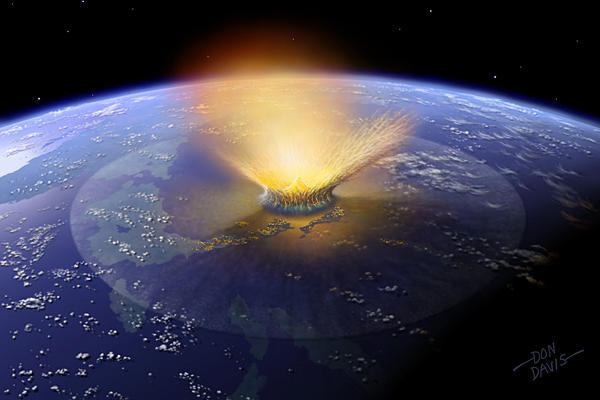
There has long been a consensus among palaeontologists that the mass extinction of the dinosaurs was triggered when a 6-mile wide asteroid hit the Earth 66 million years ago.
The narrative has been that the asteroid, slammed into the present day Yucatan Peninsula and set off volcanic eruptions, earthquakes, tidal waves, and eventually a large dust cloud that blocked the sun, ceasing photosynthesis, first killing off the herbivores dinosaurs, then the carnivores.
However, it has remained a scientific mystery why the cataclysmic event wiped out the dinosaurs, but not other animals, such as crocodiles and frogs.
Now, a new theory has emerged to explain the sudden and mass extinction, and it involved crude oil.
The study by Professor Kunio Kaiho and his team of researchers at Tohoku University, suggests that the extra-terrestrial object slammed into an oil reserve in the Yucatan, triggering a burning inferno that shot a massive amount of fine black carbon (also known as soot) into the atmosphere, forming a smoke cloud that plunged the Earth into darkness. The large dust cloud turned vast regions of the globe into deserts.
Both theories share the same “cloud of darkness” basis, but Kaiho’s study focuses less on Co2 spewing volcanoes and more on the sedimentary organic molecules.
The Japanese team examined the powdery black carbon substance, which is about a million times more light-absorbing than carbon dioxide.
Rocks at the impact site of the crater were already known to contain oil elements. In fact, a drilling expedition by the Mexican oil company Pemex in the 1950s helped lead to the discovery of the crater later in the 1980s. In present day Mexico, the region is still oil-rich.
To balance the study, Kaiho and co. took samples soot samples from rocks both nearby the impact site (in Haiti) as well as on the other side of the world (in Spain).
The chemical composition of both samples bore molecular similarities, indicating they originated from the same crude oil incineration.
Kaiho’s research suggests that the asteroid may have incinerated and sent up as much as three billion tons of soot into the sky, causing colder climates at mid-high latitudes, and drought and milder cooling at lower altitudes.
The findings were published in Scientific Reports.
